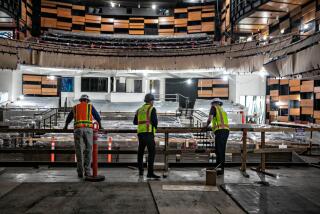Math and Sciences Complex Is College’s Newest Addition
- Share via
Question: How do you build a $12.4-million math and sciences complex that will last decades when rapid advances in technology and teaching techniques threaten to make such structures obsolete in a few years?
Answer: very carefully.
The result at Ventura College, where a sleek math and sciences complex will be dedicated Wednesday, was a project in which adaptability and leaving room for growth became crucial if it is to serve its purpose well into the next century.
“That building is designed to last for at least 50 years,” said Bob Renger, the college’s dean of science, mathematics and engineering. “We are looking at using some of the [building’s] flexibility to accommodate new technologies and new learning approaches.”
The four-building complex, the first instructional facility on campus in more than a quarter century, will house a range of sciences, including astronomy and geology. Its 50,000 square feet are jammed with the latest in technology, such as fiber optic wiring to accommodate the inevitable growth in computerized hardware.
Unfortunately, some of that sophisticated wiring won’t be hooked up to anything at first. A drive to raise $600,000 also will be launched Wednesday in an effort to recoup some of a $1-million shortfall in the $2.6-million equipment budget originally promised by the state.
Still, instructors say the shiny three-story edifice will be a vast improvement from the circa-1955 classrooms, laboratories and faculty offices housing the math and science department, which some students and faculty members have derided as little more than chicken coops.
Decades of scrubbing the surfaces in microbiology labs have worn away three layers of protective paint, revealing the bare material beneath. Work desks never designed for computers, printers, monitors and other high-tech equipment leave little room for students to work. And an environment that includes termite-ridden buildings, corroded water and gas lines and wheezing machinery that frequently breaks down is hardly conducive to teaching high-tech subject matter.
“It’s like moving from a shack into a mansion,” said biology professor Thomas O’Neill, who has taught for 43 years at the college and is the longest-serving instructor in the three-college district.
Nevertheless, when the present structures were built in 1955 they were considered state-of-the-art, said the 73-year-old O’Neill, who recalls traveling to other community colleges to speak about the sparkling new facilities.
Initially intended to last 20 years--until the construction of that long-promised four-year college the county is still awaiting--the buildings have been in use for twice their anticipated life span.
Given the ever-increasing pace of change, no one expects the new complex to endure twice its planned 50-year lifetime.
One example of the challenge: As architects began planning the complex about 1985, the infant field of biotechnology merited little consideration. Today, Ventura County is considered a preeminent biotechnology center, and biotechnology is a growing part of the college’s curriculum.
Just as science changes, so does teaching.
The college physics department has completely redesigned its curriculum in the last few years, moving away from the traditional combination of lectures and labs that has dominated college-level science education, said professor Colin Terry. Math and other disciplines are following suit.
The reason is that years of research into educational techniques showed student test scores increased about 20% when a more hands-on approach, making extensive use of computer-based learning, was employed, he said.
“The new building is geared for that kind of learning,” he said. “In many ways it’s good for us that we didn’t have it [the new complex] five years ago. . . . Maybe then we wouldn’t have known what we wanted in the new building.”
Ventura College is one of only a handful of the more than 100 community colleges in the state that have embraced the instructional changes to such a degree, Terry said.
But that means there were limited opportunities to use other educational facilities as a template for the new complex here.
More to Read
Sign up for Essential California
The most important California stories and recommendations in your inbox every morning.
You may occasionally receive promotional content from the Los Angeles Times.













